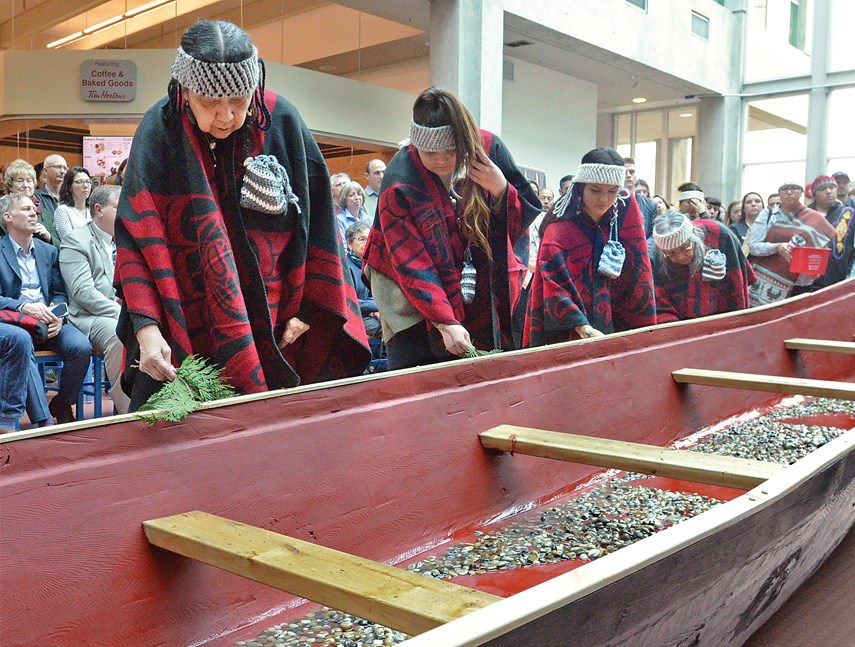On a cool March afternoon on Capilano University’s North Vancouver campus, Ses Siyam chips away at a cedar log that began as a sapling in Squamish’s Elaho Valley, perhaps 600 years ago. He is a seventh-generation carver, a hereditary chief and also one of only a handful of Squamish Nation members who still possesses the knowledge to build a traditional dugout canoe.
The university, which bears the name of a revered Squamish Nation chief, commissioned Ses Siyam to mark the school’s 50th anniversary with the legacy project. It’s intended to be a powerful gesture toward reconciliation with the five First Nations whose land Capilano University has built campuses on. But it has another and bigger task.
“It was important, as an educational institution, that we bring something in that is educational – that is learning,” said Joel Cardinal, community engagement facilitator for the university. “It’s not simply an art project or a canoe that we get to go on. There is history built into this.”
Although it will be on display in the learning commons, the legacy canoe will be put to use on the water by the Squamish Nation and the university. The carving of the canoe and its traditional uses are a tangible effort for the school to integrate Indigenous teaching into their educational mandate.
In fact, that’s how Cardinal was able to coax Ses Siyam out of his busy construction business to carve his 34th canoe.
“It was a good opportunity for people to ask questions, and participate and see part of our culture and for us to share because this is an ancient craft that’s not so available online or in books. Some stuff you can’t learn from books,” Ses Siyam said. “A lot of the university faculty, students and even the young daycare kids are coming to look and be a part of this.”
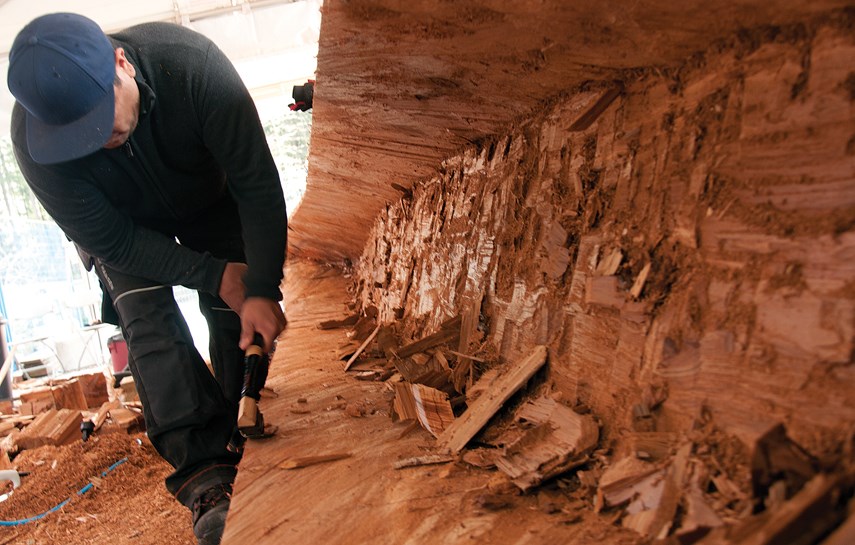
DIFFICULT TRUTHS
A university campus presents challenges and barriers for Indigenous students that largely aren’t there for settler students, said David Kirk, Indigenous faculty adviser.
“Often, they might be the only Indigenous student in the classroom. That can be intimidating,” he said. “You’ve got to put yourselves in the shoes of an Indigenous person. We walk in these institutions and we don’t typically see ourselves reflected in the curriculum, the classroom, and the setting.”
Almost all their education to that point would have ignored their history or glossed over it, Kirk noted.
But post-secondary schools have a critical role to play in reconciliation, Kirk added, because schools are the ideal institution to help restore some of what was lost.
“If we don’t know who we are, and have a connection to the land, to our culture, to our language, we’re not going to be successful at anything. So what did the government try to do for 150-plus years? Wipe out those three components from our lives,” Kirk said. “I’m a firm believer that if you take those things away from any group of people in the world – I don’t care who it is – you end up breaking them down. How do you fix that? You start building in those things.”
AND RECONCILIATION
The Truth and Reconciliation Commission of Canada produced several calls to action that involve post-secondary institutions, like CapU.
Among them: calling on government to ensure there is funding to address the backlog of First Nations students seeking higher education, calling on universities and colleges to create programs in Aboriginal languages and to support academic research into reconciliation, and “to educate teachers on how to integrate Indigenous knowledge and teaching methods into classrooms.”
That’s something Capilano University president Paul Dangerfield is pursuing and it’s why he was so supportive of the canoe project.
“What we are learning from our elders and people like Ses Siyam is that you learn by doing and you learn by listening and you learn by seeing, rather than learning from textbooks,” he said. “Traditionally, we would put people in a classroom and show some PowerPoint slides and say ‘Here you go.’”
Listening, Dangerfield said, has to be the first step in reconciliation.
In 2013, First Nations Student Services opened Kéxwusm-áyakn, which is the Swxwú7mesh language word for “a place to meet.”
The centre offers Indigenous students a place to be among their peers and study, but also connect with a groups of elders-in-residence that the school has hired to provide guidance and mentorship.
It’s also where the Indigenous staff hear directly about racism – overt, subtle and systemic – that Indigenous students face.
“Overt is more challenging in the moment but you can address overt racism a lot easier. What I find really problematic and what slowly eats away at students is the microaggressions – the little comments,” Cardinal said. “Students come to us on a very regular basis to chat and they do it in a safe space in our centre. We’re all Indigenous ourselves and we’ve all experienced these things as well.”
Kirk said he is proud of some CapU initiatives, like the legacy canoe, the Indigenous independent digital filmmaking program, and the University One for Aboriginal learners certificate, which helps students make the transition from high school to university.
“Yes, we have come a long ways in supporting this but we have a long ways to,” he said.
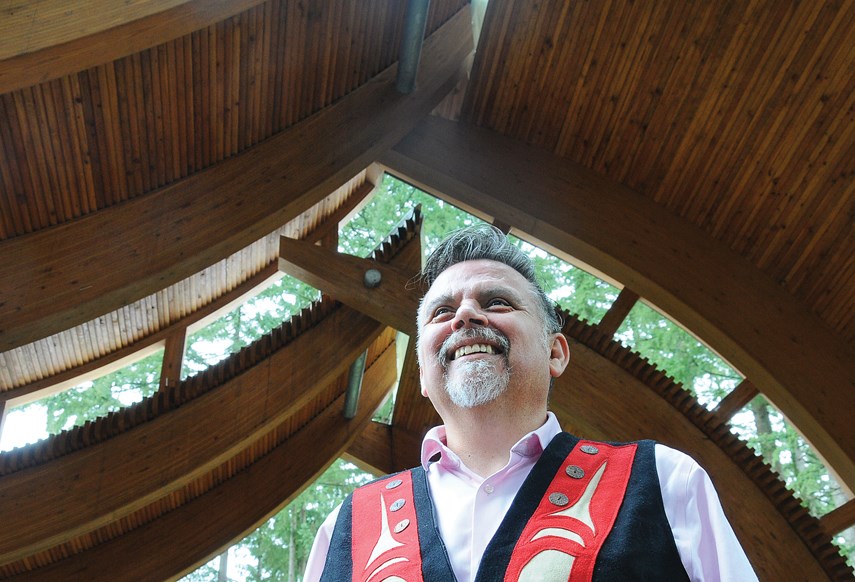
INDIGENIZE THE ACADEMY
Part of Kirk’s job now includes helping the faculty Indigenize their curriculum. Sometimes that means introducing Indigenous authors into course work. Other times, it takes more creativity.
“It’s really ensuring that the true history of people is taught,” he said. “You can’t Indigenize calculus. But Indigenous people built longhouses, or we’ve woven, or we’ve beaded. Those are all different types of math that are used.”
Dangerfield said he knew little of West Coast First Nations’ history until he became CapU’s president, but now he’s enthusiastic about seeing it spread throughout the curriculum.
“It’s actually embedded into our programing. That would be everything from our business programs, to our art programs, to our early childhood education,” Dangerfield said.
Having the Indigenous content is one thing. But Capilano needs more Indigenous staff on campus, from the bookstore clerks up to senior leadership, Kirk said.
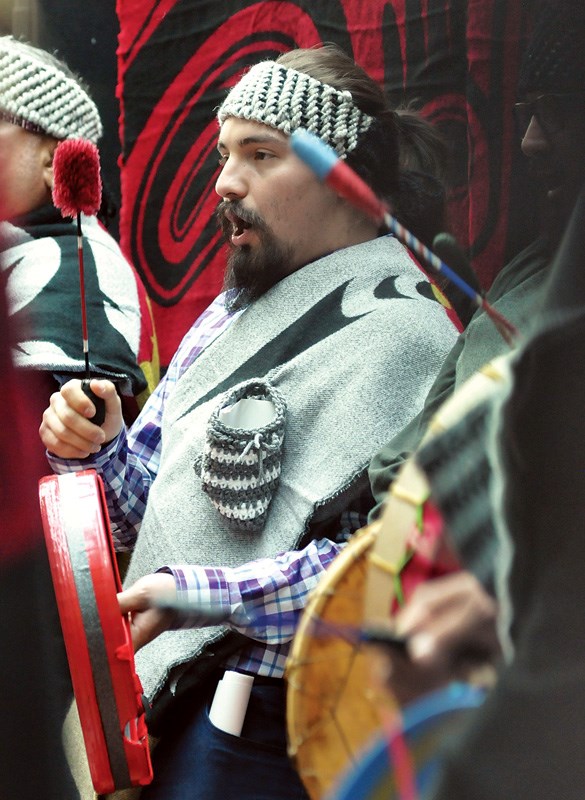
Of the 700 or so staff and faculty at CapU, only about 10 are Indigenous, Kirk said. Most universities won’t hire a new prof unless they have a PhD. Thanks to lower graduation rates in the public education system, there’s a much smaller pool of potential Indigenous faculty to choose from, Kirk said, noting the importance of the K-12 system doing its part.
“But they have a hell of a lot to share,” Kirk said, suggesting a co-teaching model could be used to see that traditional knowledge isn’t sacrificed in the name traditional credentials.
Kirk said he feels his employer is in “about the middle of the pack,” compared to other B.C. colleges and universities when it comes to reconciliation efforts.
Of the TRC calls to action, Cardinal said he has a particular interest in No. 57, which calls on governments to ensure that public servants – including university staff – are educated in the history of Aboriginal peoples and given skills-based training in intercultural competency, conflict resolution, human rights, and anti-racism.
“Employees themselves actually have a direct role in the success of students and for Indigenous students, that role is generally a barrier to their success,” he said.
Some departments need that training more than others, Cardinal said. When he was working as a financial aid adviser, Cardinal had to understand a 200-page policy book that was updated every year, but it did not offer any guidance for Indigenous students receiving financial aid from their bands. Instead, they were sent to deal with First Nations student services.
“But we don’t have access to information that the registrar does. That’s a really specific example of training that’s needed to stop the barriers to Indigenous students,” he said.
Cardinal said there is no shortage of ideas but they don’t have the authority to implement any of them on their own. That would require the will of people in senior leadership, none of whom today are Indigenous.
“To me, that is the biggest challenge,” he said.
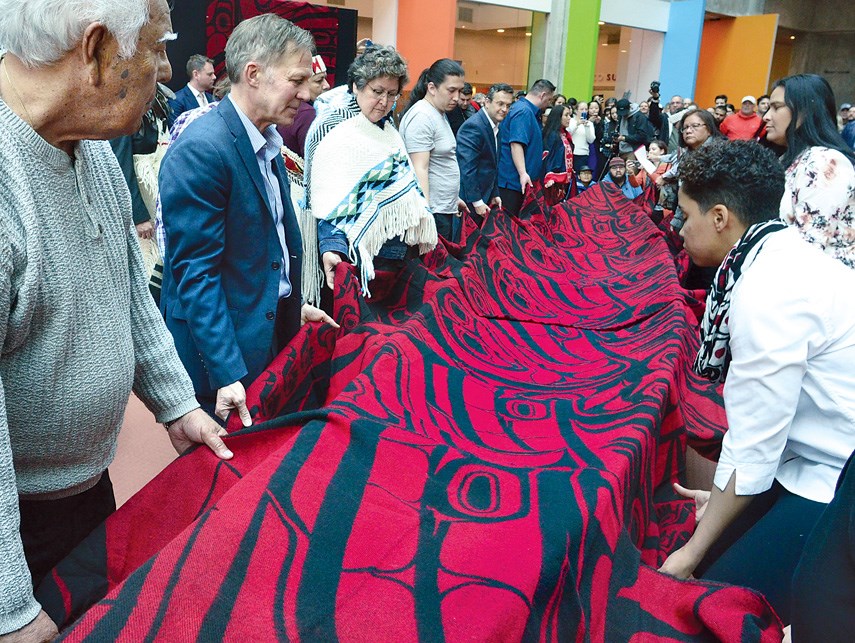
THEN & NOW
Rosemarie Williams can attest to some of the changes CapU has made over the years. Williams attended Capilano when it was a college in the 1980s and is now back to complete her bachelor of business administration degree.
Williams described the Kéxwusm-áyakn centre as a “home away from home.”
“Being on campus and not having that Indigenous student room and not having those people there to help out – it was hard in the beginning,” she said. “It’s amazing what is in place right now compared to when I attended Capilano back in the late ’80s.”
But Williams said she is eager for the faculty to find more ways to bring Indigenous teachings into the curriculum, for the benefit of Indigenous and settler students alike.
“A lot of what I’ve heard from elders, not just from our own community but in all Indigenous communities, is the importance of knowing who you are and where you come from and sharing that with the people around you,” she said, noting that some Indigenous communities have lost their traditions almost entirely. “I think it’s really important that whatever knowledge we have, we carry forward to our newer generations.”
Williams’ father was a fisherman who was taught to track salmon returns by watching for the presence of butterflies.
“There’s a science there in itself,” she said. “Some of that traditional knowledge, I think would be really great to see being used and not being disregarded.”
The canoe, Williams said, is absolutely another step in the right direction. And it could serve as a catalyst. As graduation rates for Indigenous high school students rise, more will be looking for post-secondary options. And the more CapU does to welcome them, the more will choose to go there.
“I hope this is something they continue on with,” she said.
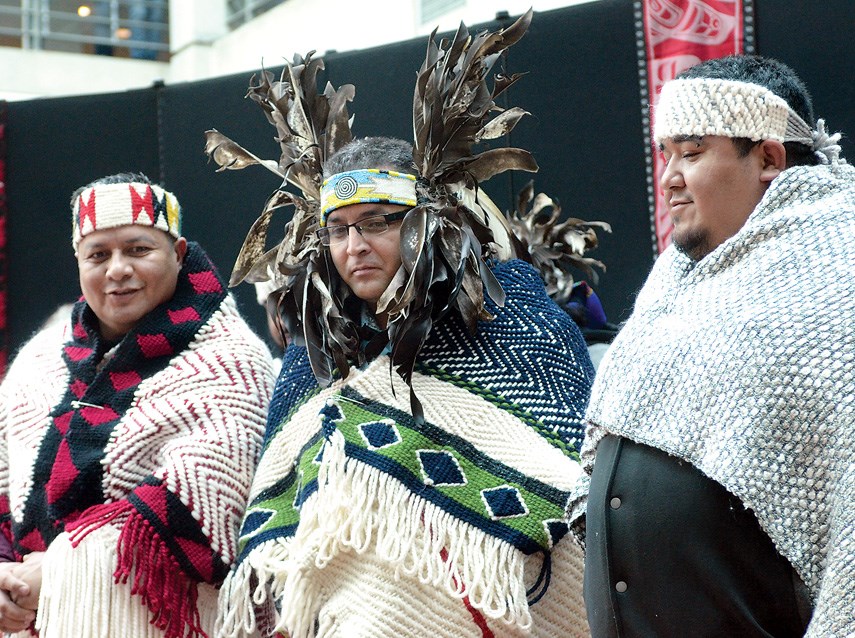
PADDLING FORWARD
In April, the school hosted a traditional awakening ceremony for the canoe, just as it would have been done in the longhouse before colonial governments banned Indigenous cultural practices.
Kirk beamed with pride watching the hours-long process play out, but was mindful of the risk the canoe presented.
Without continued commitment to reconciliation on campus, it could be misperceived as just a piece of art – like an Inukshuk at an airport.
“Canada wants our culture but not our struggles,” he said, paraphrasing, Gwen Point, another Indigenous expert in education. “It’s like that window dressing we’re doing really well. You dig a little deeper and you ask, is Canada as a whole dealing with reconciliation?”
Still, he remains optimistic. In his office, Kirk keeps an old family portrait. His grandparents attended residential schools that were designed to take away everything he and others at CapU are now trying to put back.
“That’s what I put into perspective every day. I’m here because I hope for our people. I’m that living proof. I’m that high school drop-out,” he said, adding that it’s gratifying to see Indigenous history added into curriculums for students of all ages after being glossed over for so long.
“As society at large changes, it makes it easier for us to get people on this path with us,” he said.
